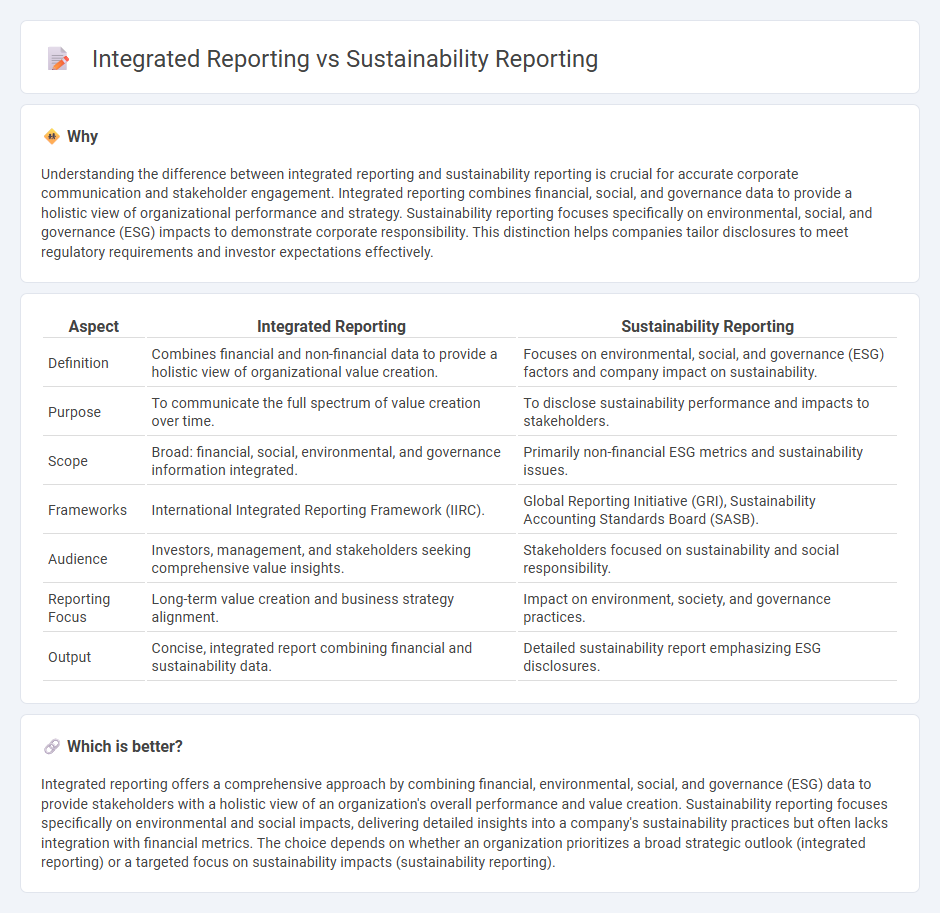
Integrated reporting combines financial and non-financial information to provide a comprehensive overview of an organization's overall performance, including governance, strategy, and sustainability. Sustainability reporting focuses specifically on environmental, social, and governance (ESG) impacts, highlighting a company's commitment to ethical practices and long-term value creation. Explore the differences and benefits of each reporting method to enhance your understanding of corporate accountability.
Why it is important
Understanding the difference between integrated reporting and sustainability reporting is crucial for accurate corporate communication and stakeholder engagement. Integrated reporting combines financial, social, and governance data to provide a holistic view of organizational performance and strategy. Sustainability reporting focuses specifically on environmental, social, and governance (ESG) impacts to demonstrate corporate responsibility. This distinction helps companies tailor disclosures to meet regulatory requirements and investor expectations effectively.
Comparison Table
| Aspect | Integrated Reporting | Sustainability Reporting |
|---|---|---|
| Definition | Combines financial and non-financial data to provide a holistic view of organizational value creation. | Focuses on environmental, social, and governance (ESG) factors and company impact on sustainability. |
| Purpose | To communicate the full spectrum of value creation over time. | To disclose sustainability performance and impacts to stakeholders. |
| Scope | Broad: financial, social, environmental, and governance information integrated. | Primarily non-financial ESG metrics and sustainability issues. |
| Frameworks | International Integrated Reporting Framework (IIRC). | Global Reporting Initiative (GRI), Sustainability Accounting Standards Board (SASB). |
| Audience | Investors, management, and stakeholders seeking comprehensive value insights. | Stakeholders focused on sustainability and social responsibility. |
| Reporting Focus | Long-term value creation and business strategy alignment. | Impact on environment, society, and governance practices. |
| Output | Concise, integrated report combining financial and sustainability data. | Detailed sustainability report emphasizing ESG disclosures. |
Which is better?
Integrated reporting offers a comprehensive approach by combining financial, environmental, social, and governance (ESG) data to provide stakeholders with a holistic view of an organization's overall performance and value creation. Sustainability reporting focuses specifically on environmental and social impacts, delivering detailed insights into a company's sustainability practices but often lacks integration with financial metrics. The choice depends on whether an organization prioritizes a broad strategic outlook (integrated reporting) or a targeted focus on sustainability impacts (sustainability reporting).
Connection
Integrated reporting combines financial and sustainability data into a unified framework, enhancing transparency and decision-making. Sustainability reporting focuses specifically on environmental, social, and governance (ESG) metrics, which are critical components included in integrated reports. This connection enables organizations to present a holistic view of value creation over time, aligning financial performance with sustainable business practices.
Key Terms
Triple Bottom Line
Sustainability reporting emphasizes environmental, social, and economic impacts, aligning with the Triple Bottom Line framework to measure a company's broader responsibility beyond financial performance. Integrated reporting combines financial and sustainability data into a cohesive narrative, providing stakeholders a comprehensive view of value creation and long-term strategy. Explore how embracing these reporting methods can enhance transparency and corporate accountability.
Materiality
Sustainability reporting emphasizes environmental, social, and governance (ESG) factors material to stakeholder concerns, often guided by frameworks like GRI that prioritize impact transparency. Integrated reporting combines financial and non-financial data, highlighting materiality through a connectivity lens to show how sustainability influences long-term value creation, aligning with the International Integrated Reporting Council (IIRC) framework. Explore detailed comparisons to understand how each approach addresses materiality for strategic decision-making and stakeholder communication.
Value Creation
Sustainability reporting emphasizes a company's environmental, social, and governance (ESG) impacts to enhance transparency and stakeholder trust, while integrated reporting combines financial and non-financial data to present a holistic view of value creation over time. Value creation in integrated reporting is assessed through capitals such as financial, manufactured, intellectual, human, social, and natural, revealing how resources are transformed to generate long-term benefits. Explore more to understand how these reporting frameworks drive strategic decision-making and stakeholder engagement.
Source and External Links
What is Sustainability Reporting? - GEP - Sustainability reporting is a form of non-financial reporting that enables companies to communicate their progress, risks, and impacts related to environmental, social, and governance (ESG) goals, providing transparency to stakeholders beyond traditional financial measures.
Sustainability Reporting: Frameworks, Benefits & Challenges - Sustainability reporting involves publicly disclosing a company's ESG performance, helping businesses manage risks, meet regulatory requirements, and demonstrate accountability and leadership in sustainable development.
Sustainability reporting - Wikipedia - Sustainability reporting refers to the disclosure of qualitative and quantitative non-financial information on environmental, social, economic, and governance issues, often guided by frameworks and sometimes required by regulation, to enhance corporate transparency and stakeholder engagement.
 dowidth.com
dowidth.com